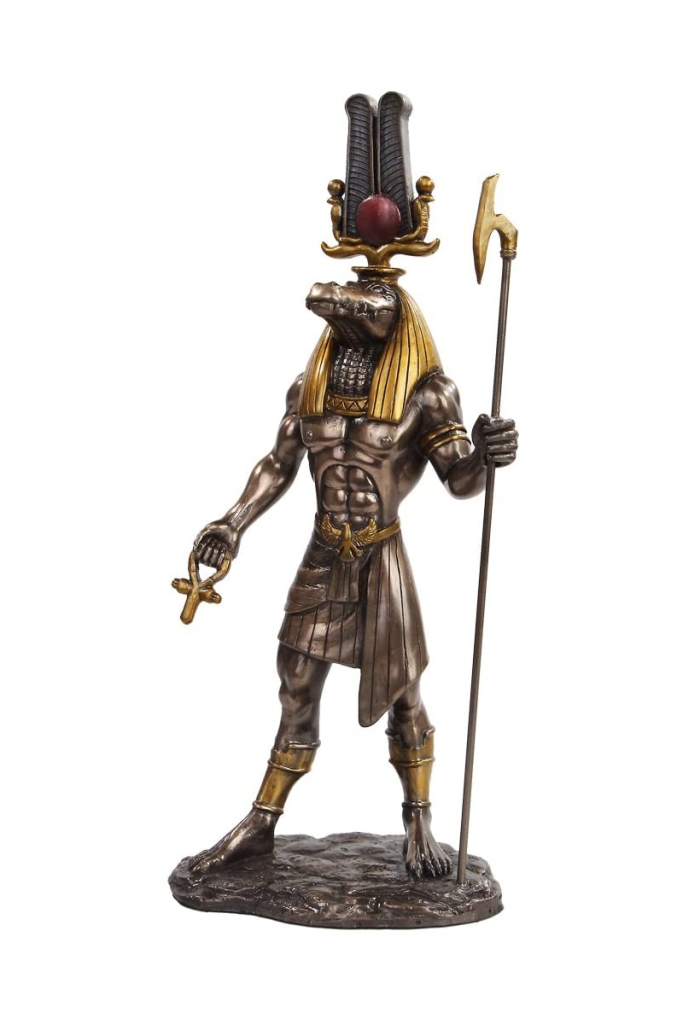Egyptian Mythological God Sobek Statue
This stunning Statue of the Egyptian God Sobek is truly remarkable and has exquisite detail and the highest sculptural quality. In his hand he holds the Ankh Cross, an ancient and sacred Egyptian symbol that essentially symbolizes life. Sobek (also called Sebek) was an Ancient Egyptian God with a complex and elastic history and nature. He is associated with the Nile Crocodile or the West African Crocodile and is represented either in its form or as a human with a crocodile head. Sobek was also associated with pharaonic power, fertility, and military prowess, but served additionally as a protective deity with apotropaic qualities (remove or cancel a malignant magical influence), invoked especially for protection against the dangers presented by the Nile. Sobek enjoyed a longstanding presence in the ancient Egyptian Pantheon, from the Old Kingdom of Egypt (2686-2181 BCE) through the Roman period (30-350 CE). He is first known from several different Pyramid Texts of the Old Kingdom, particularly from spell PT 317. The spell, which praises the pharaoh as the living incarnation of the Crocodile God, reads: “Unis is Sobek, green of plumage, with alert face and raised fore, the splashing one who came from the thigh and tail of the great goddess in the sunlight… Unis has appeared as Sobek, Neith’s son. Unis will eat with his mouth, Unis will urinate and Unis will copulate with his penis. Unis is lord of semen, who takes women from their husbands to the place Unis likes according to his heart’s fancy”.
The origin of his name, Sbk in Egyptian, is debated among scholars, but many believe that it is derived from a causative of the verb “to impregnate“. This statue of Sobek was found at Amenemhat III‘s mortuary temple (which was connected to his pyramid at Hawara in the Faiyum), serving as a testament to this king’s devotion to Sobek. Ashmolean Museum, Oxford. This Late Period (400-250 BCE) statue shows Sobek bearing the falcon head of Re-Harakhti, illustrating the fusion of Sobek and Re into Sobek-Re. Walters Art Museum, Baltimore. Though Sobek was worshipped in the Old Kingdom, he truly gained prominence in the Middle Kingdom (2055-1650 BCE), most notably under the Twelfth Dynasty Pharaoh, Amenemhat III. Amenemhat III had taken a particular interest in the Faiyum of Egypt, a region heavily associated with Sobek. Amenemhat and many of his dynastic contemporaries engaged in building projects to promote Sobek, projects that were often executed in the Faiyum. In this period, Sobek also underwent an important change, he was often fused with the falcon-headed god of divine kingship, Horus.
This brought Sobek even closer with the Kings of Egypt, thereby giving him a place of greater prominence in the Egyptian Pantheon. The fusion added a finer level of complexity to the god’s nature, as he was adopted into the divine triad of Horus and his 2 parents: Osiris and Isis. Sobek first acquired a role as a Solar God through his connection to Horus, but this was further strengthened in later periods with the emergence of Sobek-Ra, a fusion of Sobek and Egypt’s primary Sun God, Ra. Sobek-Horus persisted as a figure in the New Kingdom (1550-1069 BCE), but it was not until the last dynasties of Egypt that Sobek-Ra gained prominence. This understanding of the god was maintained after the fall of Egypt’s last native dynasty in Ptolemaic and Roman Egypt (332 BCE – 390 CE). The prestige of both Sobek and Sobek-Ra endured in this time period and tributes to him attained greater prominence, both through the expansion of his dedicated cultic sites and a concerted scholarly effort to make him the subject of religious doctrine. Egyptian Sobek Mythological God Statue sizes: 15 inches / 38 cm x 7.9 inches / 20 cm x 6.6 inches / 16.5 cm.
Egyptian God Sobek Statue on Amazon.
Egyptian God Sobek Statue on eBay.
Egyptian Statues, Gods Statues and Mythological Statues.




You must be logged in to post a comment.